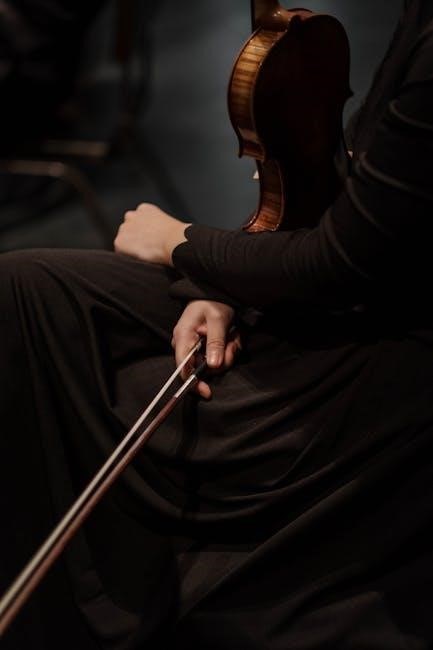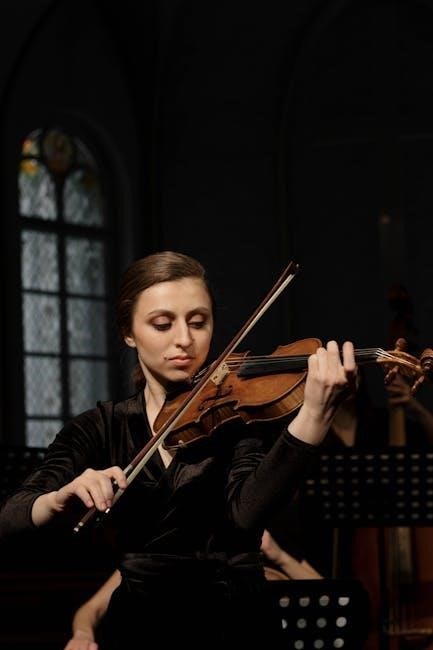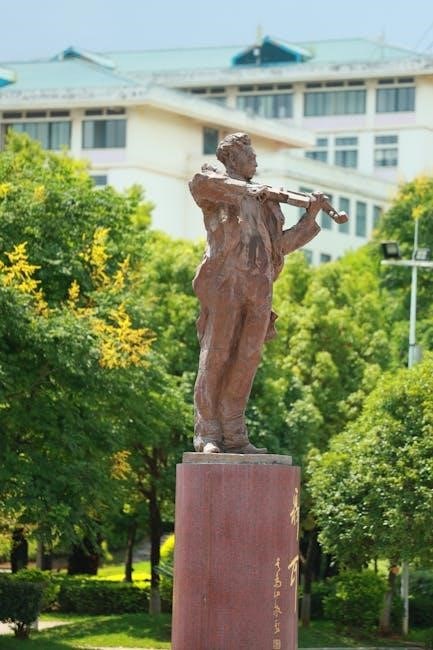Joseph Haydn, a renowned Austrian composer, crafted the Violin Concerto in G Major (Hob. VIIa:4), a vibrant piece showcasing his mastery of classical music. Composed in the early 1760s, it features three movements: Allegro moderato, Adagio, and Presto, blending elegance and technical brilliance. This concerto remains a cornerstone of classical violin repertoire, celebrated for its melodic richness and structural clarity.

Structure and Movements of the Violin Concerto in G Major
The concerto is divided into three movements: Allegro moderato, Adagio, and Presto. Each movement showcases Haydn’s mastery of sonata form, with the first movement featuring a lively exposition and the finale delivering a virtuosic conclusion.
2.1. First Movement: Allegro Moderato
The first movement of Haydn’s Violin Concerto in G Major is marked Allegro moderato, opening with a lively orchestral introduction that sets the tone for the entire concerto. The solo violin enters with a graceful, singing melody, accompanied by subtle orchestral textures. The movement follows a clear sonata form structure, beginning with an exposition that presents the thematic material. The main theme is characterized by its rhythmic energy and harmonic clarity, while the secondary theme introduces a more lyrical and expressive quality. A brief transition leads to the development section, where Haydn explores the themes in different keys, creating a sense of tension and drama. The recapitulation brings the movement back to the home key of G major, resolving the earlier harmonic explorations. Throughout, the solo violin showcases its technical agility, with passages featuring double stops, arpeggios, and other virtuosic elements. The movement concludes with a spirited cadenza, followed by a final orchestral flourish, leaving a lasting impression of both brilliance and musicality.
2.2. Second Movement: Adagio
The second movement of Haydn’s Violin Concerto in G Major is marked Adagio, offering a stark contrast to the energy of the first movement. This slow, lyrical section is characterized by its serene and reflective nature, providing a moment of emotional depth. The movement is structured in a sonata form without a development section, featuring a beautiful, singing melody introduced by the solo violin. The orchestral accompaniment is subdued, with delicate textures that support the soloist’s expressive lines. The violin part is technically demanding, requiring a deep understanding of phrasing and dynamics to convey the movement’s introspective quality. A brief cadenza-like passage allows the soloist to showcase their interpretive skills before returning to the main theme. The movement concludes with a gentle fade, leaving the listener in a state of tranquil reflection. This Adagio is a testament to Haydn’s ability to craft music that balances technical brilliance with emotional profundity, making it a highlight of the concerto. The contrast between this movement and the outer ones underscores Haydn’s mastery of musical form and expression.
2.3. Third Movement: Finale: Presto
The third movement of Haydn’s Violin Concerto in G Major, marked Presto, is a lively and exuberant finale that concludes the concerto with energy and vibrancy. This movement is characterized by its rapid tempo and intricate passages, showcasing the soloist’s technical prowess. The Presto is structured in a sonata form, with a spirited exposition that transitions between G major and E minor, creating a sense of drama and tension. The solo violin is given brilliant passages, including rapid arpeggios and double stops, which highlight the instrument’s agility and the performer’s virtuosity. The orchestra accompanies with dynamic rhythms and harmonic support, building towards a climactic cadenza that allows the soloist to dazzle with improvisatory flair. The movement concludes with a triumphant return of the main theme, leading to a thrilling and decisive finish. This Presto is a masterful blend of technical brilliance and musicality, serving as a fitting culmination to the concerto. Its lively spirit and technical demands make it a favorite among violinists and audiences alike, encapsulating Haydn’s skill in crafting engaging and virtuosic music.

Historical Context and Composition Background
Joseph Haydn’s Violin Concerto in G Major (Hob. VIIa:4) was likely composed in the early 1760s, during Haydn’s tenure as a violinist and composer at the court of Count Morzin in Vienna. This period marked Haydn’s early development as a composer, before his appointment as Kapellmeister for the Esterházy family. The concerto reflects the transitional style between the Baroque and Classical eras, showcasing Haydn’s growing mastery of sonata form and his ability to balance soloistic virtuosity with orchestral accompaniment. The work was part of a series of violin concertos Haydn wrote during this time, designed to highlight the technical capabilities of the violin while maintaining musical elegance. The G Major Concerto is particularly notable for its lively character and innovative use of harmonic and rhythmic elements, which were influential in shaping the violin concerto genre. Despite its early composition, the concerto remains popular among violinists and audiences, offering insights into Haydn’s evolving artistic style and his significant contributions to classical music.

Availability of PDF Resources for the Concerto
PDF scores of Haydn’s Violin Concerto in G Major are widely available online, with sources like Musopen.org offering free downloads. Platforms such as Sheet Music Plus and Musicnotes provide high-quality scores, including piano reductions and solo parts. Additionally, arrangements by Rebecca Wishnia and PortaHooty are accessible for free on platforms like MuseScore, catering to violinists and enthusiasts seeking both original and adapted versions of the concerto.
4.1. Sources for Downloading the PDF
Multiple online platforms offer PDF downloads of Haydn’s Violin Concerto in G Major (Hob. VIIa:4). Musopen.org provides free, copyright-free downloads of the concerto in both PDF and MIDI formats. MuseScore and Sheet Music Plus also offer high-quality scores, with arrangements by Rebecca Wishnia and PortaHooty available for free. Additionally, platforms like Musicnotes and Johnson String Instrument feature the concerto, with options for piano reductions and solo parts. The International Music Score Library Project (IMSLP) hosts the original score and parts, including urtext editions. Many of these sources cater to violinists, educators, and music enthusiasts, ensuring accessibility for both performance and study. These platforms are reliable and offer a range of versions, from solo violin and piano reductions to full orchestral scores, making them invaluable resources for musicians seeking to explore Haydn’s iconic concerto.
4.2. Features of the PDF Scores
The PDF scores of Haydn’s Violin Concerto in G Major (Hob. VIIa:4) are highly detailed and designed to meet the needs of performers and scholars. They typically include the full score, violin solo part, and piano reduction, ensuring versatility for practice and performance. Many PDFs feature urtext editions, which adhere to the composer’s original intent, free from unnecessary editorial markings. The scores are often formatted for readability, with clear notation and proper spacing to facilitate ease of use. Additionally, some versions include fingerings and bowings suggested by renowned violinists, offering practical guidance for technical execution. Dynamics, tempo markings, and articulations are meticulously indicated, preserving Haydn’s expressive intent. The PDFs may also include cadenzas, either composed by Haydn or later virtuosos, adding historical and artistic depth. Furthermore, some editions provide historical context and performance notes, enriching the musician’s understanding of the work. These features make the PDF scores invaluable resources for both professional musicians and students seeking to master Haydn’s concerto.
4.3. How to Access and Download the PDF
Accessing and downloading the PDF of Haydn’s Violin Concerto in G Major (Hob. VIIa:4) is straightforward. Visit reputable platforms like Musopen.org or IMSLP, where free, high-quality scores are available. Search for “Haydn Violin Concerto in G Major” to find the concerto. Select the desired version, such as the urtext edition, and click the download link. Some sites offer multiple formats, including PDF and MIDI, allowing you to choose based on your needs. Additionally, platforms like Sheet Music Plus provide downloadable scores for purchase, often with added features like adjustable transpositions; Ensure you verify the source’s legitimacy to avoid copyrighted material. Once downloaded, the PDF can be printed or used digitally, making it convenient for practice and performance. Many editions include a piano reduction and solo part, catering to both soloists and accompanists. This easy accessibility ensures musicians worldwide can explore and perform Haydn’s timeless concerto with ease.

Detailed Analysis of Each Movement
The Violin Concerto in G Major by Haydn is a masterpiece of classical music, with three distinct movements. Each movement showcases Haydn’s compositional genius, blending technical brilliance with emotional depth. The Allegro moderato opens with a lively, thematic dialogue between the violin and orchestra. The Adagio presents a lyrical, expressive melody, highlighting the violin’s soloistic qualities. The Finale: Presto concludes with virtuosic passages and rhythmic energy, demonstrating Haydn’s mastery of form and structure. Together, these movements create a cohesive and captivating musical experience.
5.1. Analyzing the First Movement
The Allegro moderato of Haydn’s Violin Concerto in G Major is a vibrant opening movement that sets the tone for the entire work. Composed in sonata form, it begins with a lively orchestral introduction, establishing the tonic key of G major. The solo violin enters with a graceful theme, characterized by lyrical phrasing and rhythmic precision. The movement features a well-defined structure, with an exposition that presents the primary and secondary themes, followed by a development section that explores these motifs in various keys. The primary theme, marked by ascending arpeggios, showcases the violin’s agility, while the secondary theme introduces a contrasting lyrical quality. Haydn’s use of orchestration is masterful, with interplay between the soloist and the ensemble creating a dynamic interlude. A cadenza, often performed with virtuosic flourishes, leads to the recapitulation, where the themes return in a triumphant G major. This movement exemplifies Haydn’s balance of lyricism and technical brilliance, making it a standout in the violin concerto repertoire. Its structural clarity and melodic charm ensure its enduring appeal to performers and audiences alike. The concerto’s first movement remains a cornerstone of classical violin music, reflecting Haydn’s innovative spirit and compositional mastery. Through its intricate details and expressive depth, it continues to inspire new interpretations and adaptations, solidifying its place in musical history. The availability of PDF scores and performances further ensures its accessibility and continued celebration in the modern era. As a result, the Allegro moderato stands as a testament to Haydn’s enduring legacy in classical music.
5.2. Exploring the Second Movement
The Adagio movement of Haydn’s Violin Concerto in G Major is a serene and expressive slow movement, offering a stark contrast to the vibrant Allegro moderato. Composed in the key of C major, it features a lyrical melody introduced by the solo violin, accompanied by a subtle orchestral texture. The movement follows a sonata-like structure, with a primary theme characterized by soaring arpeggios and a secondary theme marked by emotional depth. Haydn’s orchestration is refined, with delicate interplay between the soloist and the ensemble. The violin part demands precise control and phrasing, as the melodies often unfold in long, singing lines. A brief cadenza-like passage allows the soloist to display technical prowess while maintaining the movement’s contemplative atmosphere. The Adagio concludes with a gentle return to the primary theme, creating a sense of resolution. This movement highlights Haydn’s ability to craft music that is both technically demanding and emotionally resonant. PDF scores of this concerto often include detailed fingerings and phrasing suggestions, aiding performers in interpreting the movement’s nuanced expressiveness. The Adagio remains a cherished example of Haydn’s lyrical genius, offering a moment of introspection within the concerto’s overall structure. Its beauty and technical requirements make it a focal point for violinists and audiences alike.
5.3. Understanding the Third Movement
The Finale: Presto of Haydn’s Violin Concerto in G Major is a lively and virtuosic conclusion to the work, showcasing the composer’s mastery of rhythmic energy and melodic invention. Written in rondo form, the movement features a recurring theme introduced by the solo violin, which is then developed and varied throughout. The Presto is characterized by its brisk tempo and playful interplay between the soloist and the orchestra, with the violin part demanding agility and precision. Haydn’s use of arpeggios, scales, and technical runs highlights the virtuosic nature of the movement, while the orchestral accompaniment provides a driving rhythmic foundation. A brief cadenza near the end allows the soloist to demonstrate their technical prowess before the movement concludes with a triumphant flourish. PDF scores of this concerto often include detailed fingerings and tempo markings, aiding performers in navigating the movement’s technical challenges. The Finale: Presto exemplifies Haydn’s ability to blend humor, energy, and elegance, making it a thrilling conclusion to the concerto. Its technical demands and musical brilliance ensure it remains a highlight of the violin repertoire.

Performance Considerations
Performing Haydn’s Violin Concerto in G Major requires precise attention to dynamics, tempo, and phrasing. The soloist must master challenging cadenzas and technical passages, while maintaining clarity and musicality. PDF scores often include detailed fingerings and bowing suggestions to aid execution.

6.1. Violin Fingerings and Techniques
The Violin Concerto in G Major by Haydn demands advanced technical proficiency, with intricate fingerings and bowing techniques. The Allegro moderato movement features rapid arpeggios and scales, requiring precise intonation and dexterity. In the Adagio, legato phrasing and expressive dynamics are essential, with careful attention to vibrato and tonal control. The Presto finale presents challenging double stops and quick articulations, necessitating strong left-hand technique and bow accuracy.

Cadenza sections allow for artistic interpretation, with fingerings often tailored to highlight melodic themes. PDF scores provide detailed fingerings, bowings, and dynamic markings, guiding performers to achieve Haydn’s intended nuances. Proper posture and bow grip are crucial to mastering these techniques, ensuring clarity and musicality throughout the concerto.
6.2. Dynamics and Tempo Markings
The Violin Concerto in G Major by Haydn is characterized by precise tempo and dynamic markings that guide the performer in interpreting the music with authenticity. The first movement, marked Allegro moderato, features lively rhythms with dynamic contrasts, transitioning from delicate pianissimos to robust fortes. The second movement, Adagio, is marked by expressive legato playing, with dynamics often shifting between piano and mezzo-piano to create a contemplative atmosphere.
The finale, Presto, demands rapid tempos and sharp articulations, with dynamic accents that highlight the virtuosic nature of the piece. PDF scores of the concerto provide detailed markings, including crescendos, decrescendos, and phrasing instructions, ensuring performers adhere to Haydn’s intent. These markings are crucial for maintaining the balance between the soloist and the orchestra, as well as for conveying the emotional depth and technical brilliance of the work.
Adhering to these tempo and dynamic guidelines is essential for delivering a performance that honors Haydn’s compositional vision and the classical style of his era.

Arrangements and Transcriptions
Haydn’s Violin Concerto in G Major has been widely transcribed and arranged for various instruments and ensembles, reflecting its enduring popularity. One notable arrangement is for flute and orchestra, offering a fresh timbral perspective while preserving the original’s musical essence. Additionally, reductions for violin and piano are common, making the concerto accessible to students and performers without orchestral accompaniment.
Some versions include cadenzas composed by later musicians, such as Philipp Scharwenka, adding a personal touch to the solo parts. These arrangements and transcriptions not only broaden the concerto’s reach but also highlight its adaptability across different musical settings. PDF scores of these arrangements are readily available, providing performers with diverse interpretative options while staying true to Haydn’s original intentions.
Such adaptations ensure that the Violin Concerto in G Major remains a vibrant and relevant work in modern musical practice, appealing to a wide range of instrumentalists and audiences alike.

Haydn’s Impact on the Violin Concerto Form
Joseph Haydn played a pivotal role in shaping the violin concerto form, leaving an indelible mark on classical music. His concertos, including the Violin Concerto in G Major, exemplify his innovative approach to balancing the soloist and orchestra. Haydn’s works bridged the transition from the Baroque to the Classical era, introducing a more refined and expressive dialogue between the violin and orchestral accompaniment.
His concertos are characterized by their structural clarity, melodic richness, and harmonic innovation, setting a standard for future composers. Haydn’s contributions influenced prominent composers like Mozart and Beethoven, who built upon his foundations to further elevate the genre. His ability to blend technical brilliance with emotional depth ensured that the violin concerto remained a central part of classical repertoire.
Today, Haydn’s concertos continue to inspire musicians and composers, showcasing his enduring legacy in the evolution of classical music. His works remain a testament to his mastery of form and his ability to innovate within traditional frameworks.
Joseph Haydn’s Violin Concerto in G Major stands as a timeless masterpiece in classical music, offering a blend of technical brilliance and emotional depth. Its three movements—Allegro moderato, Adagio, and Presto—exemplify Haydn’s mastery of sonata form and his ability to craft melodies that resonate with listeners. The concerto’s structured yet expressive nature has made it a cornerstone of violin repertoire, inspiring generations of musicians and composers.
The availability of PDF scores has democratized access to this work, allowing performers and scholars to study and interpret it with precision. Haydn’s contributions to the violin concerto form are immeasurable, as he bridged the Baroque and Classical eras, influencing later composers like Mozart and Beethoven. His innovative approach to balancing the soloist and orchestra remains a hallmark of the genre.
